


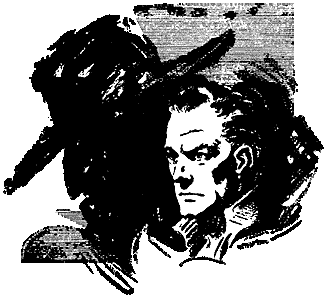 In
1942, Ray Kinstler dropped out of high school in New York City
after his Sophomore year. Having tried the High School of Music
and Art one year and the High School of Industrial Arts the next,
he abandoned a formal art education and got a job inking comic
books for Richard Hughes at $15 a week He spent less than a year
in the studios of Cinema Comics inking the pencils of Ken Battefield
on such Nedor Comics characters as The Black Terror and
Pyroman. Then he went freelance working for the comics
and for pulp magazines including one story featuring The Shadow
for Street and Smith in 1945.
In
1942, Ray Kinstler dropped out of high school in New York City
after his Sophomore year. Having tried the High School of Music
and Art one year and the High School of Industrial Arts the next,
he abandoned a formal art education and got a job inking comic
books for Richard Hughes at $15 a week He spent less than a year
in the studios of Cinema Comics inking the pencils of Ken Battefield
on such Nedor Comics characters as The Black Terror and
Pyroman. Then he went freelance working for the comics
and for pulp magazines including one story featuring The Shadow
for Street and Smith in 1945.
A lifelong admirer of the classic pen and ink artistry of such masters as Charles Dana Gibson, James Montgomery Flagg and Howard Chandler Christy, Kinstler's goal was to become an illustrator like them. The road was destined to be long and he knew he needed experience. It's no wonder that he gravitated towards the pulps where pen & ink was still the most accepted medium for the illustrations. And considering his artistic heroes, it is no surprise that he opted for the full, three-name signature.
He joined the National Arts Club in 1947 and got a studio there in 1949 under the auspices of his friend and teacher, Frank Vincent DuMond. He moved into a larger studio in 1953 and lived there for nearly 50 years. He still maintains the studio and paints there regularly.
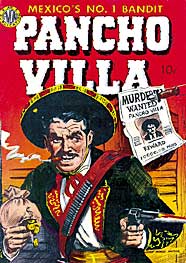
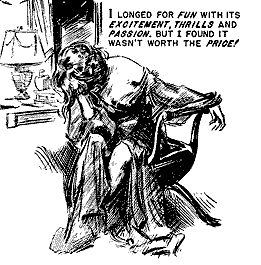 After very short stints in comics with Fawcett and DC, he began a five-year
association with Avon Comics in 1950. There he experienced the
most fun he ever had in the comics business when he created b&w
pen & ink drawings for the inside covers of over 70 comics.
In effect, these were illustrated contents pages that served as
promotional "posters" for the rest of the book. On these
Kinstler was allowed to exercise his design and rendering skills
on better paper stock than the pulps or the interior of the comic
books would ever provide.
After very short stints in comics with Fawcett and DC, he began a five-year
association with Avon Comics in 1950. There he experienced the
most fun he ever had in the comics business when he created b&w
pen & ink drawings for the inside covers of over 70 comics.
In effect, these were illustrated contents pages that served as
promotional "posters" for the rest of the book. On these
Kinstler was allowed to exercise his design and rendering skills
on better paper stock than the pulps or the interior of the comic
books would ever provide.
While producing these masterpieces of comic book art, he didn't skimp on the interior stories creating memorable examples for Avon's western, romance, science fiction, crime and war titles. The page below is from Strange Worlds #6 (February, 1952).
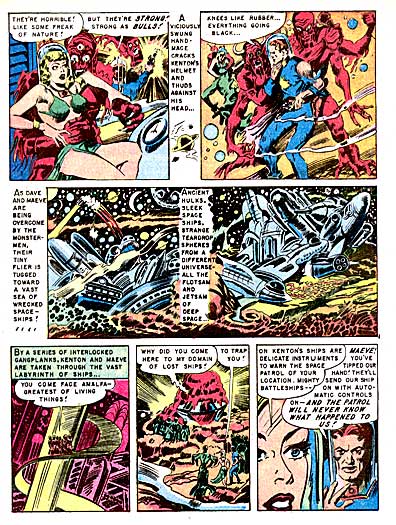
 During the early
1950s he continued his work in the pulps doing covers and lots
of interior illustrations for Short Stories, Adventure,
Ranch Romances, and many other notable titles. He
also worked in comics for Ziff-Davis, with a scant few appearances
at Lev Gleason and Atlas.
During the early
1950s he continued his work in the pulps doing covers and lots
of interior illustrations for Short Stories, Adventure,
Ranch Romances, and many other notable titles. He
also worked in comics for Ziff-Davis, with a scant few appearances
at Lev Gleason and Atlas.
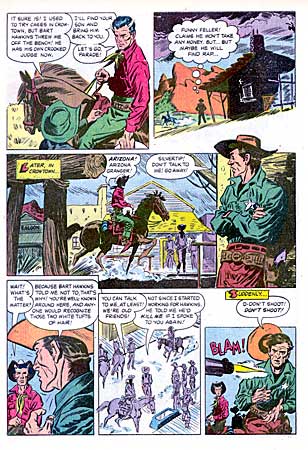 When Avon discontinued
the inside cover art pages, Kinstler traded his pen for a brush
and supplemented his Avon assignments with long stories for the
Dell Four Color series. Dell/Western editor Matt
Murphy allowed him a freedom similar to the Avon inside covers,
but here it was devoted to the telling of the story rather than
the creativity of the pen line. Dell was adapting western novels
and recent films to the comic format in 34-page comic stories.
The Kinstler titles included Silvertip (see left),
Western Marshall, Zorro (above right),
the John Wayne film, The Conqueror, the Alan Ladd film,
Santiago, and others. His association with Dell/Western
lasted through 1958.
When Avon discontinued
the inside cover art pages, Kinstler traded his pen for a brush
and supplemented his Avon assignments with long stories for the
Dell Four Color series. Dell/Western editor Matt
Murphy allowed him a freedom similar to the Avon inside covers,
but here it was devoted to the telling of the story rather than
the creativity of the pen line. Dell was adapting western novels
and recent films to the comic format in 34-page comic stories.
The Kinstler titles included Silvertip (see left),
Western Marshall, Zorro (above right),
the John Wayne film, The Conqueror, the Alan Ladd film,
Santiago, and others. His association with Dell/Western
lasted through 1958.
 By the end of the
decade, Kinstler had abandoned comics and pulps for book illustration.
Breaking in with some interior paperback illustrations in 1951,
he debuted as a paperback cover artist in 1954 with Gun Feud
at Stampede Valley and quickly graduated to one of Avon's
premier cover artists. He painted dozens of covers for them through
1959, with assignments for Bantam, Hillman, and Pyramid (including
the infamous 1956 Shadows of Shame cover, below).
By the end of the
decade, Kinstler had abandoned comics and pulps for book illustration.
Breaking in with some interior paperback illustrations in 1951,
he debuted as a paperback cover artist in 1954 with Gun Feud
at Stampede Valley and quickly graduated to one of Avon's
premier cover artists. He painted dozens of covers for them through
1959, with assignments for Bantam, Hillman, and Pyramid (including
the infamous 1956 Shadows of Shame cover, below).


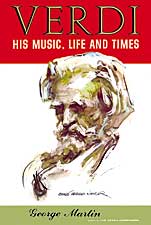 The
last half of the 1950s decade was devoted primarily to book illustration
as a new young adult fiction market had blossomed as the Baby
Boomers grew up. Illustrated biographies and coming-of-age romance
novels were big business and Kinstler's ability to create and
maintain a likeness was in high demand. When Collier's Magazine
ceased publication in 1959, it became clear to him that his goal of
a career in the slick magazines was not forthcoming.
The
last half of the 1950s decade was devoted primarily to book illustration
as a new young adult fiction market had blossomed as the Baby
Boomers grew up. Illustrated biographies and coming-of-age romance
novels were big business and Kinstler's ability to create and
maintain a likeness was in high demand. When Collier's Magazine
ceased publication in 1959, it became clear to him that his goal of
a career in the slick magazines was not forthcoming.
The aforementioned "ability to capture a likeness" had him dabbling in portraiture from the early 1950s. In 1957 he signed up with a New York City company called Portraits Incorporated and he executed a couple of portraits for them. In 1960, he painted the portrait of Forrest E. Mars, Sr. (of the Mars Candy fortune) and his new career was established. In 1962, he painted Scott Carpenter for NASA and he's never looked back.
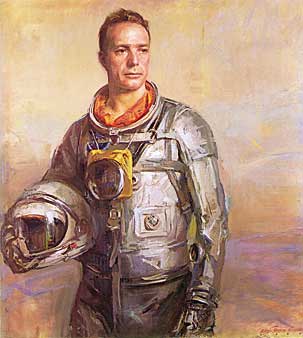
 As a portrait artist,
over the last 50 years, he's painted the official White House
portrtaits of two presidents (Reagan and Ford) and cabinet members
from every administration since the Kennedy presidency. His portrait
of John Wayne is considered by many to be the definitive one of
the Duke. He's painted Carol Burnett, Tom Wolfe, Katharine Hepburn,
Jimmy Cagney, James Montgomery Flagg, and dozens more.
As a portrait artist,
over the last 50 years, he's painted the official White House
portrtaits of two presidents (Reagan and Ford) and cabinet members
from every administration since the Kennedy presidency. His portrait
of John Wayne is considered by many to be the definitive one of
the Duke. He's painted Carol Burnett, Tom Wolfe, Katharine Hepburn,
Jimmy Cagney, James Montgomery Flagg, and dozens more.
When Kinstler was eight, he got a phone call from Bing Crosby. When he was 15 he sketched on the NYC rooftops with James Bama. When he was 27, he met and befriended James Montgomery Flagg. He knew such luminaries as Dean Cornwell, Arthur William Brown, and Howard Chandler Christy and he drew charcoal portraits of Salvador Dali, John Barrymore, Douglas Fairbanks, Leonard Bernstein, Malvina Hoffman, Ayn Rand and more before he turned 35.
He lectures and teaches art at the Art Students League: the same school where he attended F.V. DuMond's class in the mid-1940's. He's written two books on painting: Painting Faces, Figures, and Landscapes and Painting Portraits - the latter with Susan E. Meyer, whose 1974 book on James Montgomery Flagg was only made possible due to Kinstler. His knowledge and experience with Flagg over the last six years of Flagg's life provided Meyer with a first-hand view of the artist, and the care and dilligence with which Kinstler handled Flagg's art and legacy after his death in 1960 made the graphics more comprehensive.
Kinstler lives in Connecticut with his wife, Peggy. In 2005, the three of us collaborated on the production of the definitive biography of his early years - his transition from a 15-year-old comic book-inking high school dropout to his emergence 20 years later as a sophisticated painter of portraits - which he still paints in NYC using Flagg's easel.

240 pages. Available now!
in hardcover for $39
and as a deluxe signed slipcased edition with 16 extra plates for $79.
(orders now accepted)
 To learn more about Everett Raymond Kinstler, see:
To learn more about Everett Raymond Kinstler, see:| Painting Portraits | Everett Raymond Kinstler, 1971 Watson-Guptill |
| Painting Faces, Figures and Landscapes | Everett Raymond Kinstler, 1981 Watson-Guptill |
| Painting Portraits - Revised Edition | Everett Raymond Kinstler, 1987 Watson-Guptill |
| Everett Raymond Kinstler - An Artist's Journey | Art Spirit Films, 2004, narration F. Murray Abraham |
| Everett Raymond Kinstler: The Artist's Journey through Popular Culture 1942–1962 | Jim Vadeboncoeur, Jr. 2005 JVJ Publishing |
| The Vadeboncoeur Collection of Knowledge | Jim Vadeboncoeur, Jr. 2005 |
and be sure to visit the Everett Raymond Kinstler website
|
Illustrations are copyright by Everett Raymond Kinstler This page written, designed & © 2005 by Jim Vadeboncoeur, Jr. Updated 2011. |

